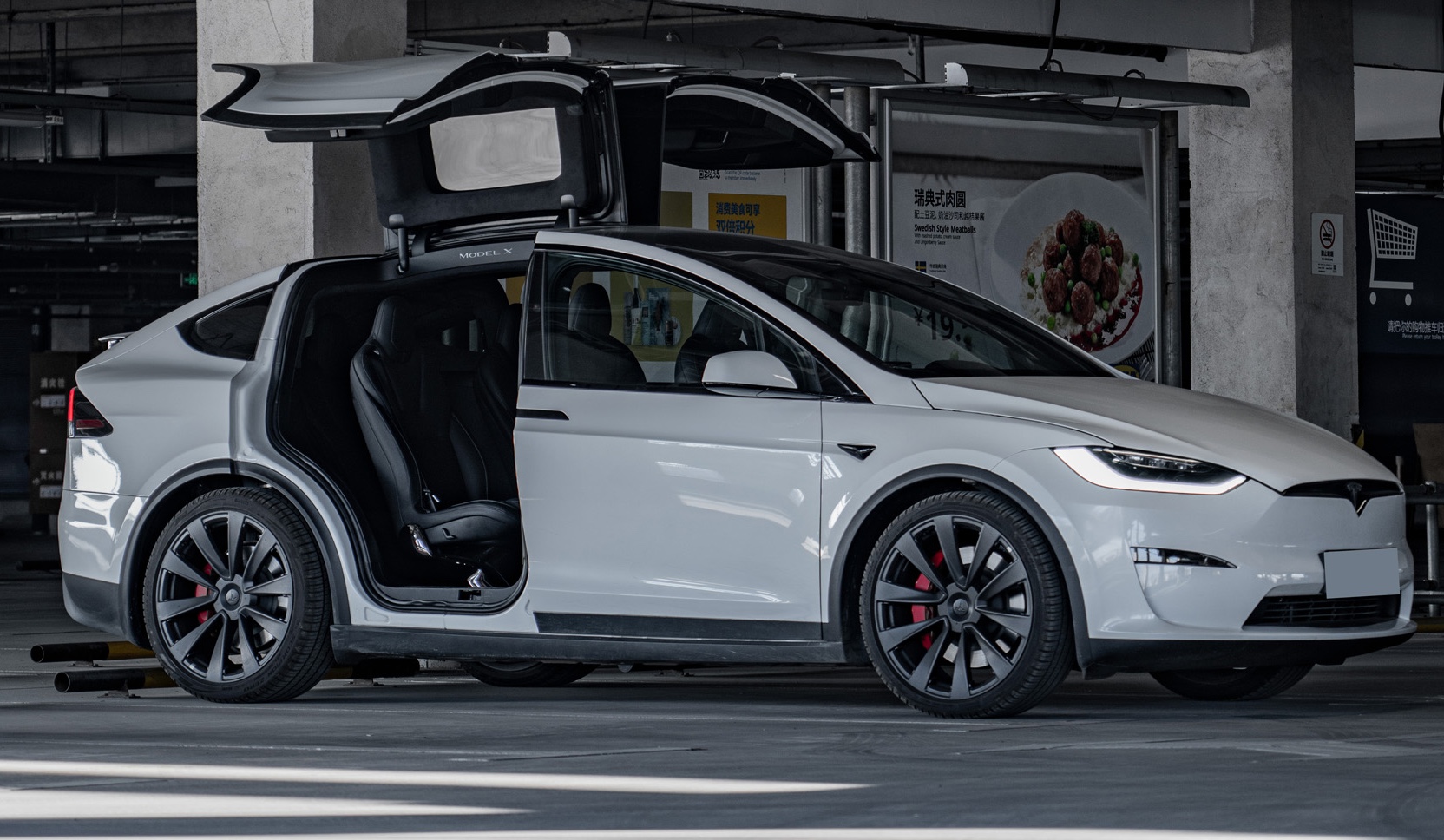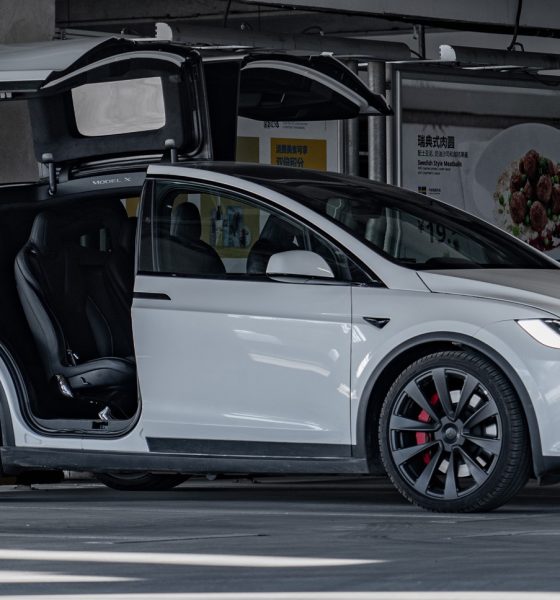Tesla (NASDAQ:TSLA) took a steep dive on the heels of the company’s Q4 and FY 2023 earnings call, dropping over 9% as of writing. With the company stating that volume growth would be tempered this year due to its focus on the next-generation platform and executives being quite vague about its guidance for 2024, analysts, including some TSLA bulls, are not happy.
Tesla actually had a record 2023, with vehicle sales growing nearly 40% year-over-year in 2023 to over 1.8 million units worldwide. Wall Street currently expects Tesla to post about 2.1 to 2.2 million vehicle sales for 2024, which would translate to a growth of about 20%. This number seems conservative and attainable enough, but Tesla simply maintained that its volume growth would be substantially lower than 2023’s ~40%.
Wedbush analyst Dan Ives shared his sentiments about Tesla’s earnings call, in a post on X. Ives described the call, which provided some high-level long-term views on the company, as another “train wreck” conference call. Following the earnings call, Ives adjusted his price target for Tesla from $350 to $315 per share, though he also noted that Wedbush remains bullish on the company.
Great to join @bsurveillance discussing another train wreck conf call in our view from Tesla and Musk lacking margin outlook and firm guidance for 24. Remain bullish for long term EV/AI vision but near term headwinds @lisaabramowicz1 @FerroTV @annmarie @BloombergTV https://t.co/E40CMG2Mg0— Dan Ives (@DivesTech) January 25, 2024
“We were dead wrong expecting Musk and team to step up like adults in the room on the call and give a strategic and financial overview of the ongoing price cuts, margin structure, and fluctuating demand. Instead, we got a high-level Tesla long-term view with another train wreck conference call,” Ives noted.
RBC analyst Tom Narayan also maintained his “Buy” rating on Tesla, though he lowered his price target from $300 to $297 per share. “We leave our delivery estimates unchanged after the vague guide, but lower our car gross margin expectations on less robust cost down opportunity,” he noted in a report. Narayan also pointed out that Tesla’s next-generation vehicle platform is still “many quarters away” from impacting the company’s numbers.
New $TSLA report from Adam Jonas: 5 thoughts post earnings call
“We reiterate our OW $TSLA rating ($345 price target) which offers over 80% upside from current levels which we believe is compelling in proportion to the investment level within our US auto coverage.” pic.twitter.com/TdZ2cLavdc— Sawyer Merritt (@SawyerMerritt) January 25, 2024
Morgan Stanley’s Adam Jonas, for his part, pointed out that Tesla almost did not provide any guidance during the call. He also observed that there were no “AI rabbits” pulled out of Tesla’s hat during the call, which was highlighted by Musk’s conservative comments about Dojo. Despite this, Morgan Stanley opted to maintain its “Overweight” rating and $345 price target on Tesla, with a bear case PT of $100 and a bull case PT of $500 per share.
While the sentiments surrounding Tesla’s Q4 and FY 2023 earnings call seem generally negative, some analysts opted to take a more optimistic stance on the company. Canaccord lowered its price target for Tesla from $267 to $234 per share, though the firm also noted that it is time for investors to be patient about the company. The firm noted that it remains bullish about Tesla’s long-term prospects.
NEWS: Canaccord Genuity has lowered its $TSLA price target to $234 (from $267), maintains a BUY rating.
They put out a good note:
“It’s time to be patient. The next-generation vehicle, FSD upgrades, margin improvement, and Optimus will likely bring an acceleration in revenue…— Sawyer Merritt (@SawyerMerritt) January 25, 2024
“It’s time to be patient. The next-generation vehicle, FSD upgrades, margin improvement, and Optimus will likely bring an acceleration in revenue growth. But not this year — 2024 will be subdued; probably a trough, but still relatively slow (we model ~18% y\y revenue growth). Growth curves are seldom smooth, and Tesla is no different.
“We are still quite bullish on Tesla’s long-term growth prospects. We think EVs will replace ICE vehicles despite recent countervailing narratives. We see vehicle autonomy as one of the highest value-creating technologies to be deployed. Ever. And Tesla, with its razor/ razorblade approach, is a leader in this real-world AI. We think Tesla is Apple on steroids as it focuses on manufacturing and a higher level of vertical integration. Tesla is THE sustainability behemoth, in our opinion,” the firm noted.
The critical metric, auto gross margins ex credits, came in at 17%, compared to the Street at 17.3%. I was expecting 16.7%.
While this missed the Street, it marks the end of four consecutive quarters of margin decline, up from 16.3% in the Sep-23.
Over this is a positive.— Gene Munster (@munster_gene) January 24, 2024
Longtime Tesla bull Gene Munster of Deepwater Asset Management also pointed out that Tesla’s auto gross margins for the past quarter ended a streak of dropping margins. “The critical metric, auto gross margins ex credits, came in at 17%, compared to the Street at 17.3%. I was expecting 16.7%. While this missed the Street, it marks the end of four consecutive quarters of margin decline, up from 16.3% in the Sep-23. Over, this is a positive,” Munster wrote on X.
Don’t hesitate to contact us with news tips. Just send a message to simon@teslarati.com to give us a heads up.

News
Tesla has passed a critical self-driving milestone Elon Musk listed in Master Plan Part Deux
Tesla China announced that the company’s Autopilot system has accumulated 10 billion kilometers of driving experience.
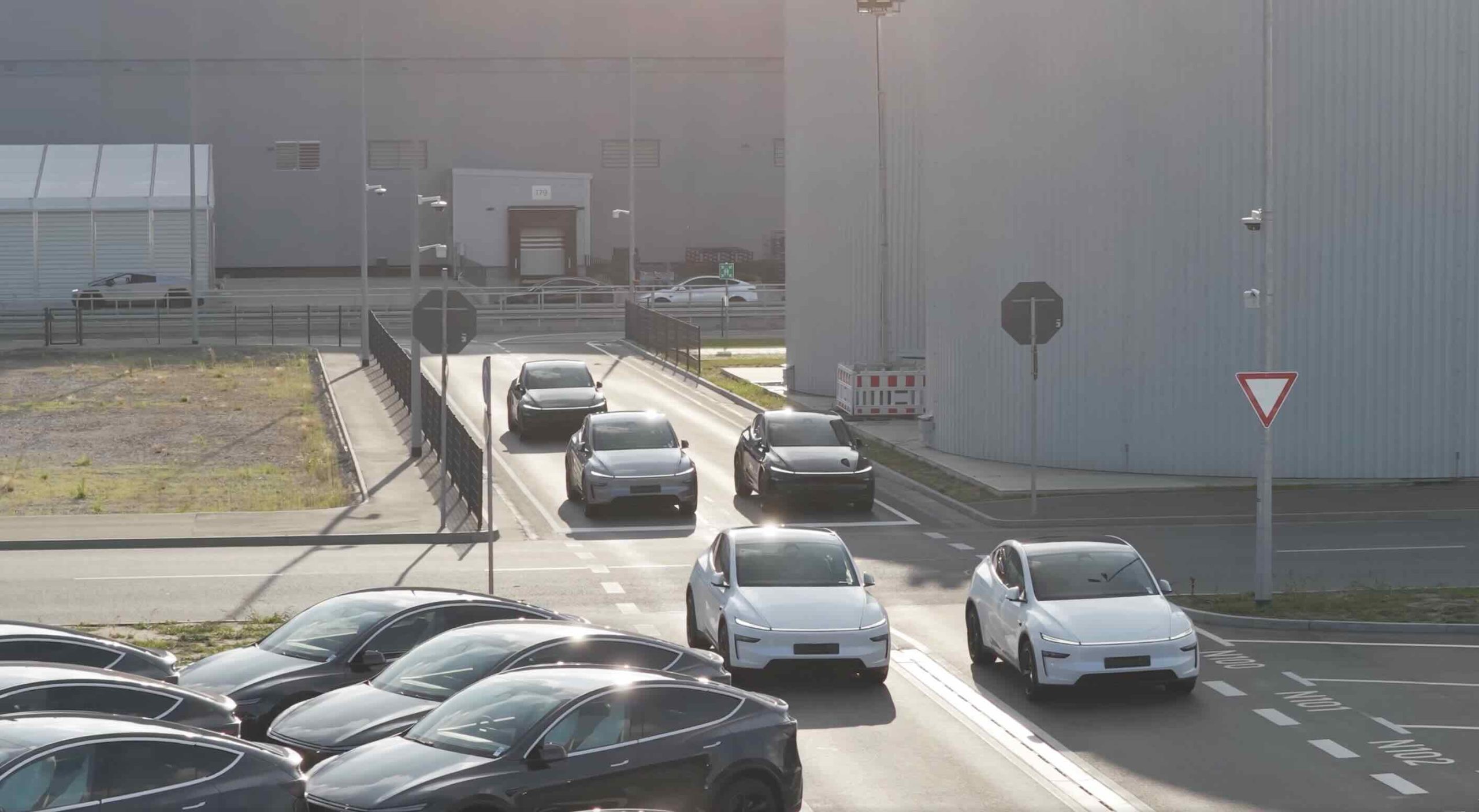
Tesla has passed a key milestone, and it was one that CEO Elon Musk initially mentioned more than nine years ago when he published Master Plan, Part Deux.
As per Tesla China in a post on its official Weibo account, the company’s Autopilot system has accumulated over 10 billion kilometers of real-world driving experience.
Tesla China’s subtle, but huge announcement
In its Weibo post, Tesla China announced that the company’s Autopilot system has accumulated 10 billion kilometers of driving experience. “In this respect, Tesla vehicles equipped with Autopilot technology can be considered to have the world’s most experienced and seasoned driver.”
Tesla AI’s handle on Weibo also highlighted a key advantage of the company’s self-driving system. “It will never drive under the influence of alcohol, be distracted, or be fatigued,” the team wrote. “We believe that advancements in Autopilot technology will save more lives.”
Tesla China did not clarify exactly what it meant by “Autopilot” in its Weibo post, though the company’s intense focus on FSD over the past years suggests that the term includes miles that were driven by FSD (Beta) and Full Self-Driving (Supervised). Either way, 10 billion cumulative miles of real-world data is something that few, if any, competitors could compete with.
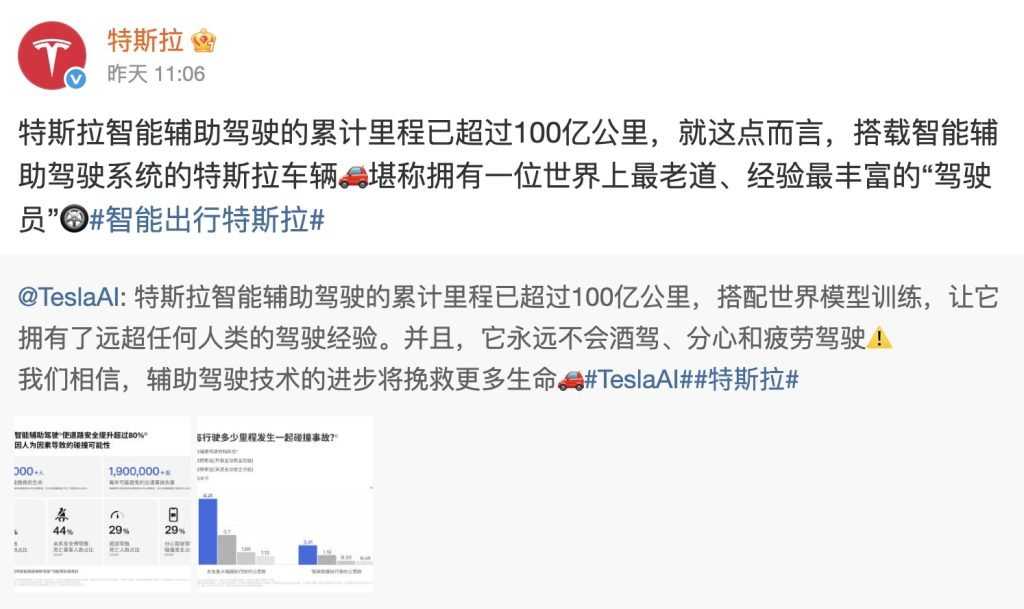
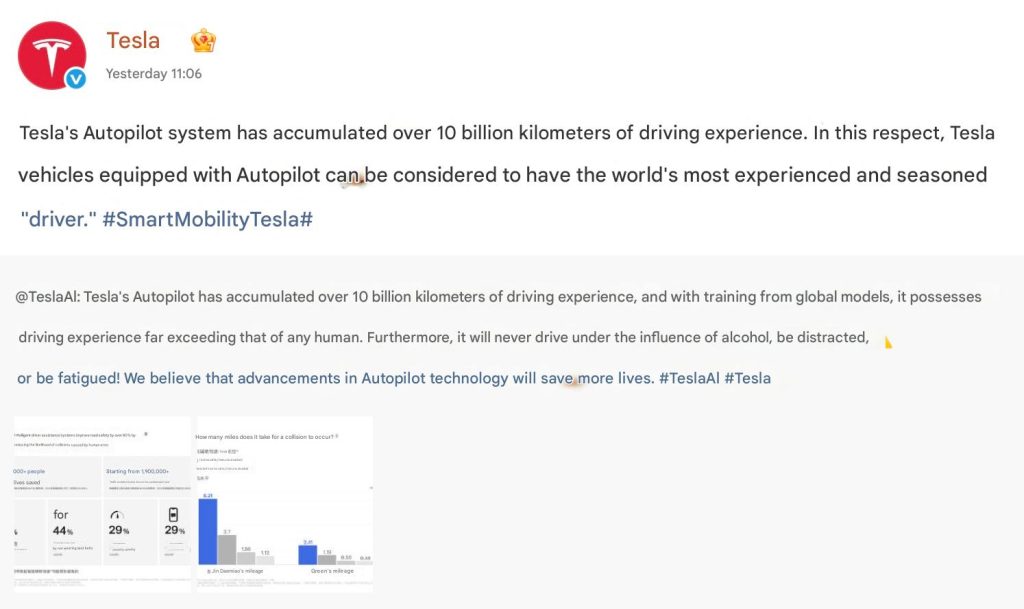
Elon Musk’s 10-billion-km estimate, way back in 2016
When Elon Musk published Master Plan Part Deux, he outlined his vision for the company’s autonomous driving system. At the time, Autopilot was still very new, though Musk was already envisioning how the system could get regulatory approval worldwide. He estimated that worldwide regulatory approval will probably require around 10 billion miles of real-world driving data, which was an impossible-sounding amount at the time.
“Even once the software is highly refined and far better than the average human driver, there will still be a significant time gap, varying widely by jurisdiction, before true self-driving is approved by regulators. We expect that worldwide regulatory approval will require something on the order of 6 billion miles (10 billion km). Current fleet learning is happening at just over 3 million miles (5 million km) per day,” Musk wrote.
It’s quite interesting but Tesla is indeed getting regulatory approval for FSD (Supervised) at a steady pace today, at a time when 10 billion miles of data has been achieved. The system has been active in the United States and has since been rolled out to other countries such as Australia, New Zealand, China, and, more recently, South Korea. Expectations are high that Tesla could secure FSD approval in Europe sometime next year as well.
Elon Musk
SpaceX maintains unbelievable Starship target despite Booster 18 incident
It appears that it will take more than an anomaly to stop SpaceX’s march towards Starship V3’s refinement.
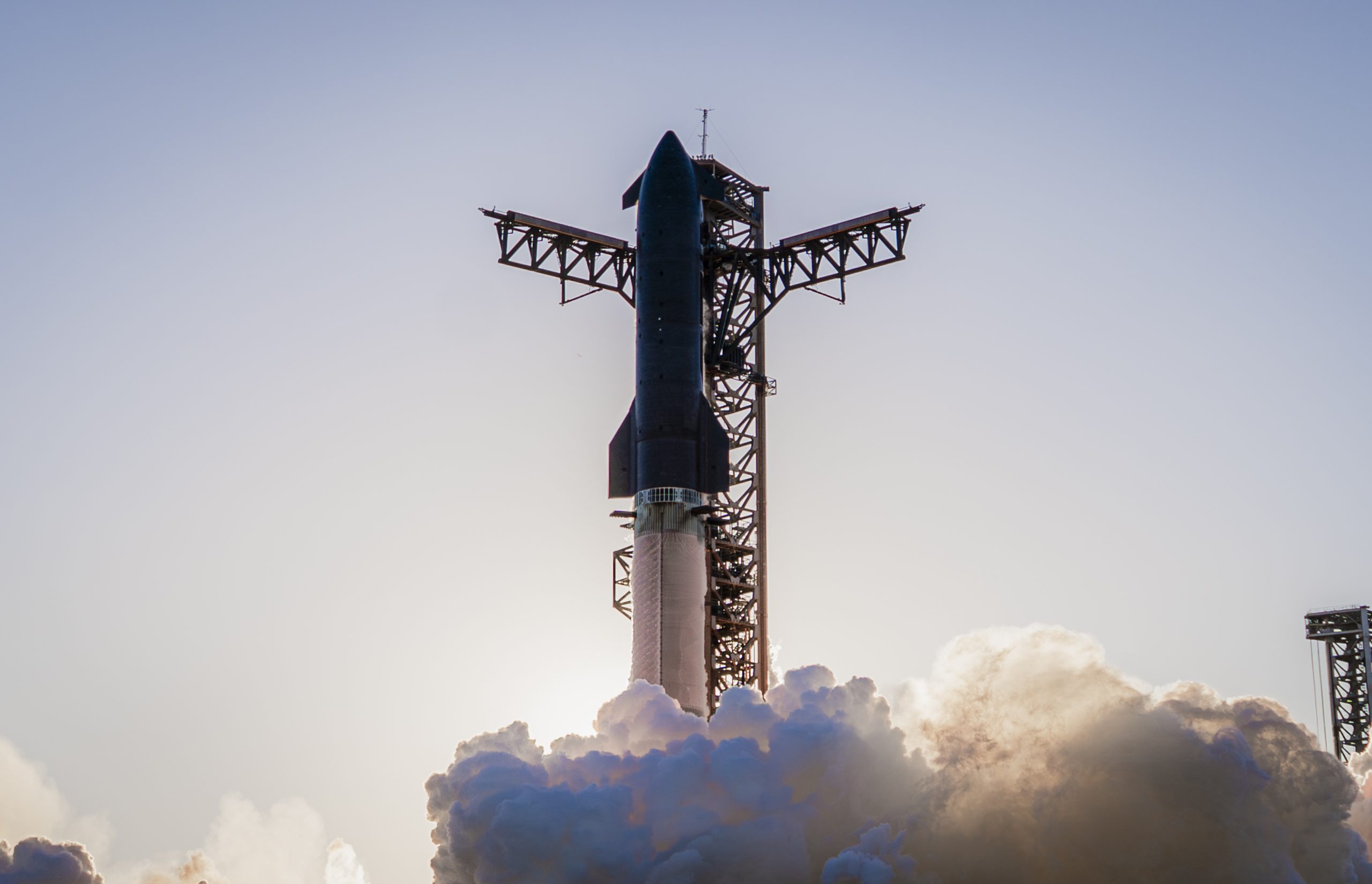
SpaceX recently shared an incredibly ambitious and bold update about Starship V3’s 12th test flight.
Despite the anomaly that damaged Booster 18, SpaceX maintained that it was still following its plans for the upgraded spacecraft and booster for the coming months. Needless to say, it appears that it will take more than an anomaly to stop SpaceX’s march towards Starship V3’s refinement.
Starship V3 is still on a rapid development path
SpaceX’s update was posted through the private space company’s official account on social media platform X. As per the company, “the Starbase team plans to have the next Super Heavy booster stacked in December, which puts it on pace with the test schedule planned for the first Starship V3 vehicle and associated ground systems.”
SpaceX then announced that Starship V3’s maiden flight is still expected to happen early next year. “Starship’s twelfth flight test remains targeted for the first quarter of 2026,” the company wrote in its post on X.
Elon Musk mentioned a similar timeline on X earlier this year. In the lead up to Starshp Flight 11, which proved flawless, Musk stated that “Starship V3 is a massive upgrade from the current V2 and should be through production and testing by end of year, with heavy flight activity next year.” Musk has also mentioned that Starship V3 should be good enough to use for initial Mars missions.
Booster 18 failure not slowing Starship V3’s schedule
SpaceX’s bold update came after Booster 18 experienced a major anomaly during gas system pressure testing at SpaceX’s Massey facility in Starbase, Texas. SpaceX confirmed in a post on X that no propellant was loaded, no engines were installed, and personnel were positioned at a safe distance when the booster’s lower section crumpled, resulting in no injuries.
Still, livestream footage showed significant damage around the liquid oxygen tank area of Booster 18, leading observers to speculate that the booster was a total loss. Booster 18 was among the earliest vehicles in the Starship V3 series, making the failure notable. Despite the setback, Starship V3’s development plans appear unchanged, with SpaceX pushing ahead of its Q1 2026 test flight target.
News
Tesla Sweden faces fresh union blockade at key Gothenburg paint shop
Allround Lack works with painting and damage repair of passenger cars, including Teslas.
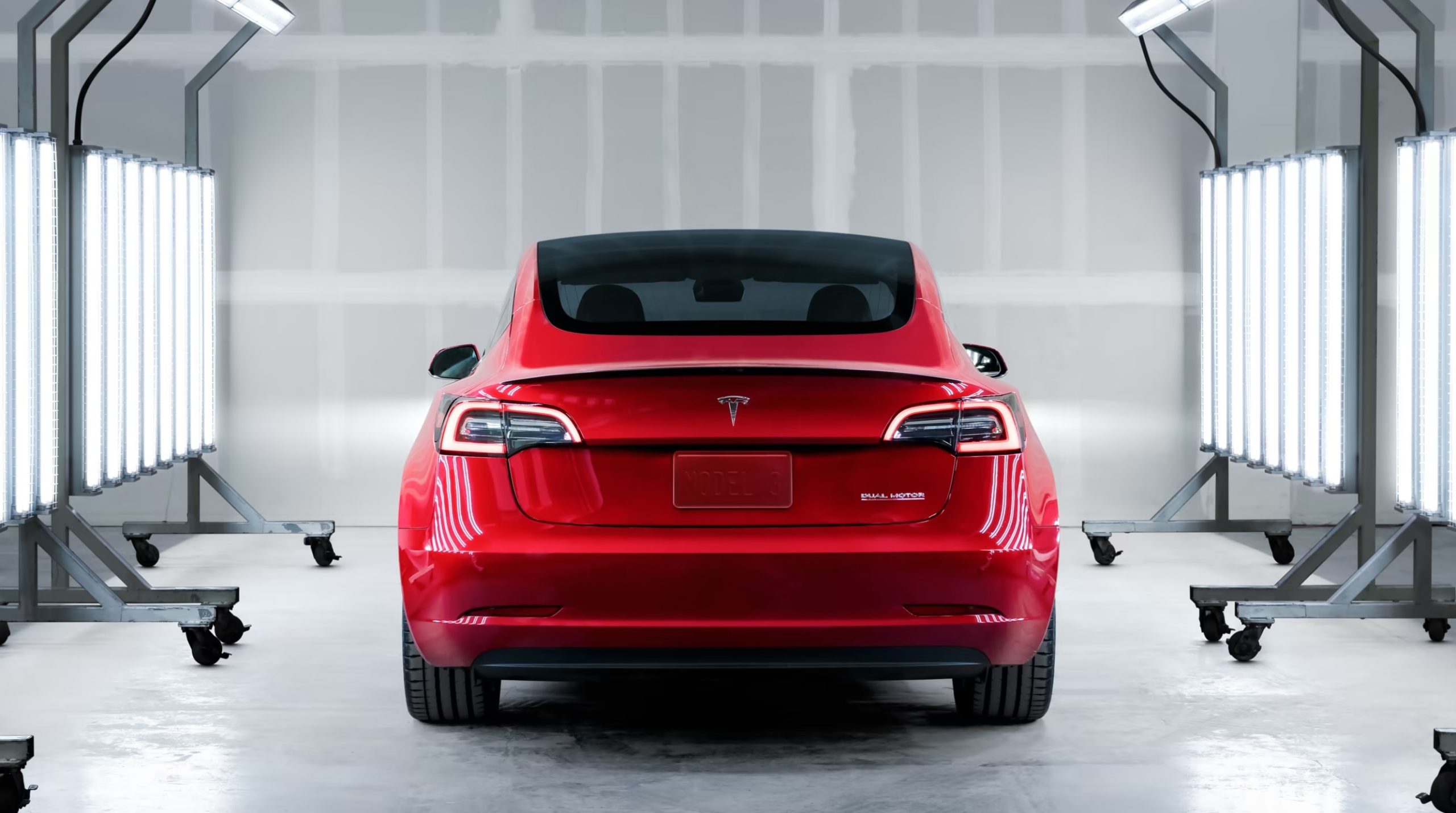
Tesla’s ongoing labor conflict in Sweden escalated again as the trade union IF Metall issued a new blockade halting all Tesla paintwork at Allround Lack in Gothenburg.
Allround Lack works with painting and damage repair of passenger cars, including Teslas. It currently employs about 20 employees.
Yet another blockade against Tesla Sweden
IF Metall’s latest notice ordered a full work stoppage for all Tesla-related activity at Allround Lack. With the blockade in place, paint jobs on Tesla-owned vehicles, factory-warranty repairs, and transport-damage fixes, will be effectively frozen, as noted in a report from Dagens Arbete. While Allround Lack is a small paint shop, its work with Tesla means that the blockade would add challenges to the company’s operations in Sweden, at least to some degree.
Paint shop blockades have been a recurring tool in the longstanding conflict. The first appeared in late 2023, when repair shops were barred from servicing Tesla vehicles. Days later, the Painters’ Union implemented a nationwide halt on Tesla paint work across more than 100 shops. Since then, a steady stream of workshops has been pulled into the conflict.
Earlier blockades faced backlash from consumers
The sweeping effects of the early blockades drew criticism from industry groups and consumers. Employers and industry organization Transportföretagen stated that the strikes harmed numerous workshops across Sweden, with about 10 of its members losing about 50% of their revenue.
Private owners also expressed their objections. Tibor Blomhäll, chairman of Tesla Club Sweden, told DA in a previous statement that the blockades from IF Metall gave the impression that the union was specifically attacking consumers. “If I get parking damage to my car, I pay for the paint myself. The company Tesla is not involved in that deal at all. So many people felt singled out, almost stigmatized. What have I done as a private individual to get a union against me?” Blomhäll stated.
In response to these complaints, IF Metall introduced exemptions, allowing severely damaged vehicles to be repaired. The union later reopened access for private owners at workshops with collective agreements. The blockades at the workshops were also reformulated to only apply to work that is “ordered by Tesla on Tesla’s own cars, as well as work covered by factory warranties and transport damage on Tesla cars.”
